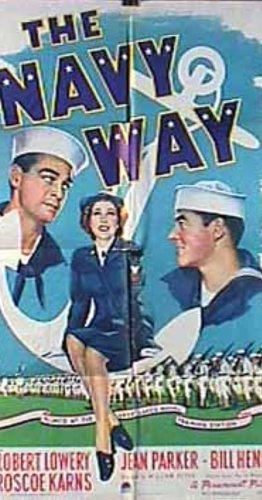

It wouldn't be fair to just describe this as a piece pf propaganda, but the rallying call for would-be sailors is writ large. It's quite a personable affair, following the trials and tribulations of a group of recruits as they adjust from their life on civvy street to the new disciplines of the Service.
Robert Armstrong as a Navy CPO sees to the training of such various navy recruits as Robert Lowery, William Henry, Larry Nunn, Roscoe Karns, and Tom Keene in The Navy Way. This was a Pine-Thomas production from Paramount and was shot at the Great Lakes Naval Training Station.
Mixing comedy, drama and a ton of patriotism, this late war film is a last minute attempt to get new blood in so the old blood can have a little rest. Cleverly opening with flashbacks of a bunch of the recruit's past, this is the beef stew of society as all types end up as buddies, some in with the most honorable of dreams, the others almost pushing and screaming in their efforts to stay out.
During the war years, the prolific Pine-Thomas producing team made several low-budget war-themed b&w programmers on an independent basis that were then released through Paramount. The team managed to squeeze a lot of production value into these films by including lots of location shots taken at actual military bases and training facilities.
A routine program filler with some familiar faces in the cast -- Rosco Karns, Robert Armstrong of "King Kong," Horace McMahon in a walk-on. It's sort of a training film -- "What to Expect When You Join the Navy and What You Should Avoid Doing.
During WWII, all of the Hollywood studios, even the little ones, began churning out bazillions of patriotic propaganda films. They were designed to increase the public's support for the war as well as glamorize the idea of joining the service to serve in the war effort.
The Navy Way is a WW2 propaganda film helping to recruit men into the US Navy. The story follows a bunch of the usual green recruits through the selection process and then the various gruelling training regimes they must undergo.